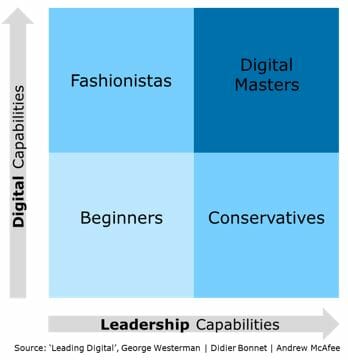
If organizations want to remain relevant in the digital age, they will have to extract maximum value from current and future technological possibilities. The influence of technology on business models has been widely recognized, while the use of technology is no longer a privilege of corporate organizations alone. In fact, it is precisely the start-ups and SMEs that make frequent use of this; the democratization of technology. But in addition to the success stories, there are also countless organizations that are stranded in their digital transformation. The adoption of technology alone is not enough. In ‘Leading Digital’, George Westerman et al. indicate that the organizations that are exceptionally successful are distinguished by the way in which the digital transformation is led. A conclusion that was already known in 2014. The development of, and with it the knowledge about, technology is progressing at a rapid pace. Leadership development seems to be more difficult. What role does Enterprise Architecture actually play in this?
The ever-increasing development of technology, the use of cloud and the increasing connectivity based on microservices create an increasing number of possibilities to develop products and services. Digital transformations are therefore realizing an increase in the complexity of the information provision of many organizations and the environment in which it operates.
The studies from ‘Leading Digital’ have shown that the digital masters distinguish themselves not only by having technological skills, but also by having a clear vision, stimulating initiatives, and showing commitment to change that starts at the top of the company, known as leadership qualities. This requires much more a behavioural change in the organization than, for example, simplifying a transformation in detailed planning. Therefore, in a digital transformation, the governance of the organization also becomes more complex.
So how can we deal with complexity? As mentioned, propagating a vision is important. This must be a vision that recognizes that there will be uncertainties. This can be supported by looking at an organization as a complex system in the context of its environment. By recognizing complexity and apply sensemaking, we enable organizations to transform in a controlled manner. Architecture makes an important contribution to sensemaking. Architecture is therefore an important part of the required leadership in digital transformations and contributes to getting the most value from technology.
In the white papers Design for Chaos and Situational Architecturing, we provide a number of tools for architects that help to apply Sensemaking Architecture to give direction to transformations in the context of a complex and changing environment.
These white papers are part of a series on Sensemaking Architecture. With Sensemaking Architecture, we present an innovative vision on architecture as part of DyA®. The goal of this vision is to ensure that Enterprise Architecture can continue to make an impact and contribute to achieving successful digital transformations that deliver real value through technology.
In the DyA® Webinar, we will discuss the latest white paper Situational Architecturing.
The DYA® Webinar is coming up on March 11. (Please note: the webinar is in Dutch) You can register here.
The white papers that have been published so far can be found at:

 English | EN
English | EN 